
As it is a country with many different tribes and ethnic groups, the music of Indonesia itself is also very diverse, coming in hundreds of different forms and styles. Every region have its own culture and art, and as a result traditional music from area to area also uniquely differs from one another. For example, each traditional music are often accompanied by their very own dance and theatre. Contemporary music scene have also been heavily shaped by various foreign influences, such as America, Britain, Japan, Korea, and India.

The angklung is a musical instrument from the Sundanese people in Indonesia made of a varying number of bamboo tubes attached to a bamboo frame. The tubes are carved to have a resonant pitch when struck and are tuned to octaves, similar to Western handbells. The base of the frame is held in one hand, while the other hand shakes the instrument, causing a repeating note to sound. Each performer in an angklung ensemble is typically responsible for just one pitch, sounding their individual angklung at the appropriate times to produce complete melodies.

The Sasak people live mainly on the island of Lombok, Indonesia, numbering around 3.6 million. They are related to the Balinese in language and ancestry, although the Sasak are predominantly Muslim while the Balinese are predominantly Hindu. Sasak people who practice pre-Islamic beliefs are also known as Sasak Boda in reference to the name of the Sasak people's original religion, Bodha.
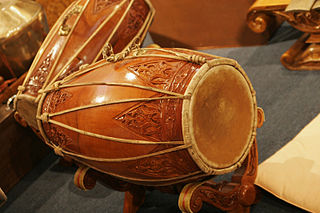
Kendang or Gendang is a two-headed drum used by people from the Indonesian Archipelago. Kendang is one of the primary instruments used in the Gamelan ensembles of Javanese, Sundanese, and Balinese, the Kendang ensemble as well as various Kulintang ensembles in Indonesia, Brunei, Malaysia, Singapore, and the Philippines. It is constructed in a variety of ways by different ethnic groups. It is a relation to the Indian mridangam double-headed drum.

Dance in Indonesia reflects the country's diversity of ethnicities and cultures. There are more than 1,300 ethnic groups in Indonesia. Austronesian roots and Melanesian tribal forms are visible, and influences ranging from neighboring Asian and even western styles through colonization. Each ethnic group has its own dances: there are more than 3,000 original dance forms in Indonesia. The old traditions of dance and drama are being preserved in the many dance schools which flourish not only in the courts but also in the modern, government-run or supervised art academies.

Javanese dance is the dances and art forms that were created and influenced by Javanese culture in Indonesia. Javanese dance movement is controlled, deliberate and refined. Javanese art often displays a finesse, and at the same time a serene composure which is elevated far above everything mundane. Javanese dance is usually associated with courtly, refined and sophisticated culture of the Javanese kratons, such as the bedhaya and srimpi dance. However, in a wider sense, Javanese dance also includes the dances of Javanese commoners and villagers such as ronggeng, tayub, reog, and jaran kepang.

Reog or Réyog is a traditional Indonesian dance in an open arena that serves as folk entertainment, contains magical elements, the main dancer is a lion-headed person with a peacock feather decoration, plus several masked dancers and Kuda Lumping. Reog is one of the performing arts from the northwestern region of East Java and Ponorogo is the region where Reog originated. The city gate of Ponorogo is decorated with warok and gemblak, two characters who were present at the time when Reog is performed. Reog is one of Indonesia culture that is still very strong with mystical elements and mysticism.

Cirebonese mask dance is a local indigenous art form of Cirebon in Java, including Indramayu and Jatibarang, West Java and Brebes, Central Java. It is called mask dance because the dancers use masks when dancing. There is a lot of variety in Javanese mask dance, both in terms of the dance style and the stories to be conveyed. Sometimes the mask dance can be performed by solo dancers, or it can also be performed by several people. Tari topeng cirebon comprised Panji, Samba, Rumyang, Tumenggung and Kelana. Each mask represents different meanings. Panji represents holiness like a new born person. Samba represents a child and excitement. Rumyang represents a teenager and life. Tumenggung represents a wise person and loyalty. And last Kelana represents emotions, anger and hatred. All these meanings influence the dance movements. Panji has slow and soft dance movements, while Samba has fast dance movements.

Gandrung is a traditional dance from Indonesia. Gandrung has many variations and is popular in Bali, Lombok and Eastern Java among the Balinese, Sasak and Javanese. The most popular variation is gandrung from the Banyuwangi region in the eastern peninsula of Java, so much that the city is often referred as Kota Gandrung or "the city of gandrung". Originally a ritual dance dedicated to the goddess of rice and fertility, Dewi Sri, it is currently performed as a social dance of courtship and love in communal and social events, or as a tourist attraction. Gandrung Sewu Festival is held at Banyuwangi annually.

Gendang beleq is a dance and music performance from Lombok island, Indonesia. It is a popular performance among the native Sasak people.

Sundanese dances is a dance tradition that is a part of ritual, artistic expression as well as entertainment and social conduct among the Sundanese people of West Java and Banten, Indonesia. Sundanese dance is usually cheerful, dynamic and expressive, with flowing movements in-sync with the beat of kendang accompanied with Gamelan degung music ensemble.
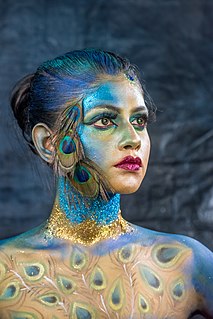
The peacock dance or peafowl dance is a traditional Asian folk dance that describes the beauty and the movement of peacocks. There are several peacock dance traditions developed in Asia, among others are peacock dances of Myanmar, and in the western and northern parts of Cambodia, West Java in Indonesia, also peacock dances of Indian subcontinent in Southern India, Sri Lanka, and Bangladesh.

Pura Lingsar was built by Anak Agung Ngurah in 1714, located 15 km from Mataram. Lingsar origin from sasak language mean clear revelation from God, the area has a spring, which scared by Sasak people, who belief Wetu Telu.
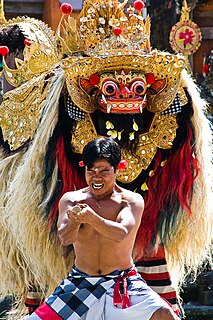
Barong dance is a style of traditional Balinese and Javanese dance from Bali and Java, Indonesia. The dance demonstrates about the mythological depiction of animals that have supernatural powers and could protect humans. Barong is the king of the spirits, leader of the hosts of good, and enemy of Rangda, the demon queen and mother of all spirit guarders in the mythological traditions of Bali. The Barong dance featured battle between Barong and Rangda to represent the eternal battle between good and evil.

Bayan is a village located in Bayan Subdistrict in North Lombok, Indonesia.
Rudat dance is a traditional dance of Sasak people in Lombok, West Nusa Tenggara, originated from Indonesia. This dance demonstrates pancak silat martial art movements. Rudat dance might be performed by a group costumed and dressed up like prajurit (warrior) with a songkok.
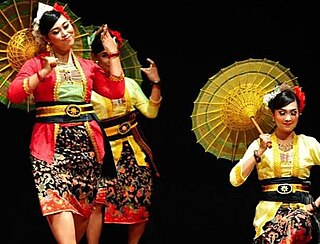
Payung dance is a folk dance-drama tradition of the Minangkabau-Malay ethnic group in Sumatra, Indonesia. This dance is a Minangkabau version of other Malay dances from Sumatra. Folk theatre such as toneel and sandiwara often incorporate payung dance as part of the show. The payung (umbrella) is the main prop used in this dance. The payung dance symbolizes affection and the relationship of young people and is usually performed by three or four dancers. The dance originates from Western Sumatra, Indonesia.

Sisingaan or also known as Gotong Singa, Singa Ungkleuk, Singa Depok, Kuda Ungkleuk, Pergosi or Odong-odong, is a traditional Sundanese lion dance originated from Subang, West Java, Indonesia. This lion dance performance marked by a form of an ark or palanquin that resembles a lion. The lion ark or lion-shaped effigy is carried by a group of dancers who perform various attractions accompanied by traditional music. The lion palanquin is being ride by a children. This dance usually performed to celebrate the child's circumcision ceremony, where the child is carried on a lion around the kampung (village).
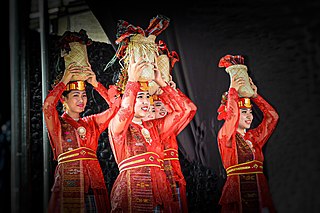
Tandok dance is a traditional Batak dance originating from the North Sumatra, Indonesia. This dance tells about the activities of harvesting rice using tandok carried out by mothers in the fields. In addition, this dance also contains the importance of family values between each other.



























